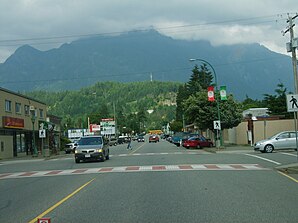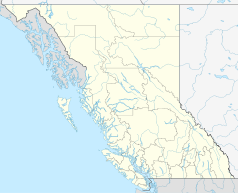Hope (British Columbia)
| Hope | ||
|---|---|---|
 Downtown Hope |
||
| Location in British Columbia | ||
|
|
||
| State : |
|
|
| Province : | British Columbia | |
| Regional District : | Fraser Valley | |
| Coordinates : | 49 ° 23 ′ N , 121 ° 26 ′ W | |
| Height : | 42 m | |
| Area : | 41.42 km² | |
| Residents : | 5969 (as of 2011) | |
| Population density : | 144.1 inhabitants / km² | |
| Time zone : | Pacific Time ( UTC − 8 ) | |
| Postal code : | V0X | |
Hope is a small town of nearly 6,000 people in the Canadian province of British Columbia , located on the border between the coastal area known as the Lower Mainland and the arid hinterland known as the Plateau . It is located at the confluence of the Fraser and Coquihalla Rivers at the end of a narrow pass, the Fraser Canyon , which begins at Lytton . This is where the region known as the Lower Mainland begins downstream and extends to the coast of Vancouver . 2 km west of the city center in the district of Silver Creek , the Silverhope Creek coming from the south flows into the Fraser River.
history

| Climate diagram | ||||||||||||||||||||||||||||||||||||||||||||||||
|---|---|---|---|---|---|---|---|---|---|---|---|---|---|---|---|---|---|---|---|---|---|---|---|---|---|---|---|---|---|---|---|---|---|---|---|---|---|---|---|---|---|---|---|---|---|---|---|---|
| ||||||||||||||||||||||||||||||||||||||||||||||||
Early history
The region was already visited by humans in the Milliken phase (7500-6000 BC). The region is the border between the cultural areas of the coastal inhabitants and the plateau dwellers. Above all the Stó: lō moved upstream and caught mainly salmon in the fish-rich fishing grounds.
Fur trade and gold rush
Simon Fraser came to what is now Hope via the Fraser in 1808, but it wasn't until 1848 that the difficult to walk Hope Trail was opened. With the Fraser Canyon Gold Rush in 1858, massive immigration began, mainly of men from California . That same year a difficult trail was built from Bellingham Bay, and in 1859 Governor James Douglas had a trail built into the north-facing areas to bring the prospectors there. The men came here to move further north, into the Cariboo area . Most came up the Fraser River by ship. From Yale, the Cariboo Road (also called Cariboo Wagon Road or Great North Road ) began at times . The wagon trail led through Barkerville , Lytton, Ashcroft and Quesnel, then on to Williams Creek. In 1860 Edgar Dewdney and Walter Moberly opened the Dewdney Trail from Hope to Similkameen (now Highway 3 runs here).
Transport links
Nevertheless, the gold rush largely bypassed Hope, as did the railroad construction from 1880 to 1888. This Canadian Pacific Railway crossed all of Canada, but it mainly benefited Yale . It was not until 1889 that the first sawmill was built in Hope, although the railway construction required a great deal of wood. It was not until 1911-18 that the Kettle Valley Railway was built with five complex tunnels and several bridges, the Quintette Tunnels through Coquihalla Canyon. How risky these route constructions were, became apparent in 1913 when the Great Northern Railway was built on the east side of Fraser Canyon. At Hell's Gate , a landslide destroyed the entire structure. There has only been a safe road there since the 1950s. Nevertheless, from 1914 the Kettle Valley Railway Bridge spanned the Fraser at Hope, where the Great Northern Railway completed a station in 1916. In 1929 the settlement was first declared a village, but in 1942 it was endangered by a huge forest fire. In the same year, Japanese were interned in the nearby Sunshine Valley because they were considered opponents of the war after the attack on Pearl Harbor .
After the Second World War , the Canadian railways got into a crisis that continues to this day, to which the Kettle Valley Railway Line fell victim in 1959 ; it was closed. 1965 was as Hope for the city, also the largest landslide (occurred landslide ) in the recorded history of British Columbia, known as " Hope Slide ". Highway 3 had to be closed. But that same year the Trans-Canada Highway ( Highway 1 ) was completed, and in 1978 the Coquihalla Highway ( Highway 5 ) began. However, until today it is often closed due to heavy snowfall or landslides.
With the establishment of the Skagit Valley Recreation Area , nature tourism began in 1972. It was followed in 1984 by the Alexandra Bridge Provincial Park, with a much more ecological focus . In 1992 the city became the District of Hope .
The airfield is located about 5 kilometers west of the municipality ( IATA code : YHE, ICAO code : CYHE). The airfield only has an asphalt runway that is 1,207 meters long.
Demographics
The census in 2011 showed a population of 5,969 inhabitants for the small town. The population has decreased by 3.5% compared to the 2006 census, while the population in British Columbia increased by 7% at the same time.
economy
The median wage for workers in Hope was C $ 21,305 in 2006, compared to C $ 24,867 in the province of British Columbia.
Current situation
After a long period of restrained growth, on March 4, 1929, the political municipality ( Village Municipality ) was founded and the associated granting of local self-government .
As in many parts of British Columbia, tourism is growing steadily in Hope . In addition to the natural beauties that are most easily accessible to hikers, rafters and kayakers (e.g. the Coquihalla Canyon Provincial Park ), the place itself offers its history. This applies to the Hope Museum , but also to the Historic Christ Church Anglican of 1861. The Hope Arts Gallery and the Japanese Friendship Garden in Memorial Park as well as 20 large wooden statues are also attractions. Hope is likely to be one of the few places that chainsaw carving is in use.
Trivia
The films Rambo ( First Blood , 1982) with Sylvester Stallone , Mörderischer Vorsprung with Sidney Poitier and K2 - The Last Adventure with Michael Biehn were shot in and around Hope.
See also
literature
- Helen B. Akrigg, GPV Akrigg: British Columbia Chronicle. 1847-1871. Gold and Colonists. Discovery Press, Vancouver 1977, ISBN 0-919624-03-0 .
Web links
- Hope ( English, French ) In: The Canadian Encyclopedia .
- Official website of the District of Hope
- Community website
- Hope Standard website , the local newspaper
- Yale Heritage Site north of Hope near Yale, History of the Region ( April 30, 2008 memento in the Internet Archive )
Remarks
- ↑ E.g. in February 2008: Coquihalla remains closed, in: Hope Standard, February 14, 2008 ( Memento of March 31, 2008 in the Internet Archive )
- ↑ Hope Community Profile. Census 2011. In: Statistics Canada . September 7, 2012, accessed October 1, 2012 .
- ↑ Hope Community Facts. In: BCStats . Retrieved October 1, 2012 .
- ^ Origin Notes and History. Hope. In: GeoBC . Retrieved October 1, 2012 .
- ^ IMDB, Filming Locations for First Blood

